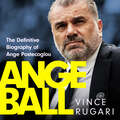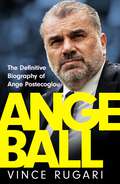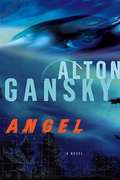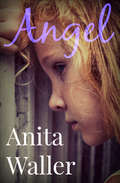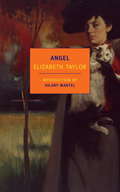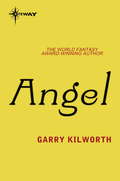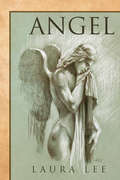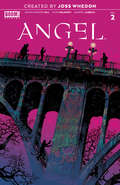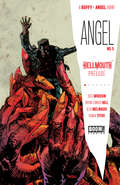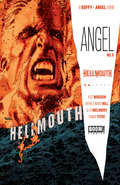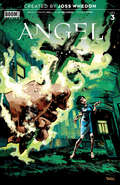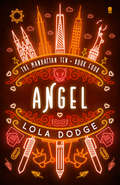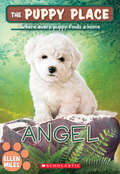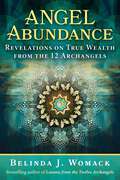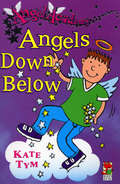- Table View
- List View
Angeball: The Definitive Biography of Ange Postecoglou
by Vince RugariThe definitive biography and ultimate origin story of Ange Postecoglou, the Premier League's most intriguing new manager and instigator of the 'Angeball' phenomenon that has taken the football world by storm.It has taken no time at all for fans of Tottenham Hotspur to fall completely in love with Ange Postecoglou and his 'Angeball' brand of front-foot football. To those who have followed his intriguing journey - from a five-year-old Greek immigrant, to a marauding left-back in the Australian National Soccer League, to a pioneering coach who has won trophies on three different continents - it is no surprise at all. 'Big Ange' did the same thing in Glasgow with Celtic (five trophies in two seasons), and in Japan with Yokohama F Marinos.Before that, he claimed four titles with his boyhood club South Melbourne, travelled the globe with Australia's junior national teams, set a national record with a 36-game unbeaten streak at Brisbane Roar, and guided the 'Socceroos' to their greatest achievement, winning the Asian Cup in 2015. Fuelled by an unshakable belief in himself and his ideas, Postecoglou's unique, mesmerising style of football is inspired by the kind of teams he would enjoy watching as a child with his father. And it works. It turns sceptics into believers and then into full-blown disciples.Drawing on dozens of interviews with Postecoglou and his players, coaches, colleagues, friends and foes, and reams of archival material, Angeball delves into the heart and soul of a man who has reshaped the football landscape. It explores the dynamics behind his coaching brilliance, his complicated relationship with the game in his homeland, and the profound impact he has had on fans worldwide.
Angeball: The Definitive Biography of Ange Postecoglou
by Vince RugariThe definitive biography and ultimate origin story of Ange Postecoglou, the Premier League's most intriguing new manager and instigator of the 'Angeball' phenomenon that has taken the football world by storm.It has taken no time at all for fans of Tottenham Hotspur to fall completely in love with Ange Postecoglou and his 'Angeball' brand of front-foot football. To those who have followed his intriguing journey - from a five-year-old Greek immigrant, to a marauding left-back in the Australian National Soccer League, to a pioneering coach who has won trophies on three different continents - it is no surprise at all. 'Big Ange' did the same thing in Glasgow with Celtic (five trophies in two seasons), and in Japan with Yokohama F Marinos.Before that, he claimed four titles with his boyhood club South Melbourne, travelled the globe with Australia's junior national teams, set a national record with a 36-game unbeaten streak at Brisbane Roar, and guided the 'Socceroos' to their greatest achievement, winning the Asian Cup in 2015. Fuelled by an unshakable belief in himself and his ideas, Postecoglou's unique, mesmerising style of football is inspired by the kind of teams he would enjoy watching as a child with his father. And it works. It turns sceptics into believers and then into full-blown disciples.Drawing on dozens of interviews with Postecoglou and his players, coaches, colleagues, friends and foes, and reams of archival material, Angeball delves into the heart and soul of a man who has reshaped the football landscape. It explores the dynamics behind his coaching brilliance, his complicated relationship with the game in his homeland, and the profound impact he has had on fans worldwide.
Angeball: The Definitive Biography of Ange Postecoglou
by Vince RugariThe definitive biography and ultimate origin story of Ange Postecoglou, the Premier League's most intriguing new manager and instigator of the 'Angeball' phenomenon that has taken the football world by storm.It has taken no time at all for fans of Tottenham Hotspur to fall completely in love with Ange Postecoglou and his 'Angeball' brand of front-foot football. To those who have followed his intriguing journey - from a five-year-old Greek immigrant, to a marauding left-back in the Australian National Soccer League, to a pioneering coach who has won trophies on three different continents - it is no surprise at all. 'Big Ange' did the same thing in Glasgow with Celtic (five trophies in two seasons), and in Japan with Yokohama F Marinos.Before that, he claimed four titles with his boyhood club South Melbourne, travelled the globe with Australia's junior national teams, set a national record with a 36-game unbeaten streak at Brisbane Roar, and guided the 'Socceroos' to their greatest achievement, winning the Asian Cup in 2015. Fuelled by an unshakable belief in himself and his ideas, Postecoglou's unique, mesmerising style of football is inspired by the kind of teams he would enjoy watching as a child with his father. And it works. It turns sceptics into believers and then into full-blown disciples.Drawing on dozens of interviews with Postecoglou and his players, coaches, colleagues, friends and foes, and reams of archival material, Angeball delves into the heart and soul of a man who has reshaped the football landscape. It explores the dynamics behind his coaching brilliance, his complicated relationship with the game in his homeland, and the profound impact he has had on fans worldwide.
Angel
by Alton L. GanskyBack Cover Blending action and suspense with deep spiritual insights, Gansky creates memorable, thought-provoking tales. -STEVEN JAMES. author of the critically acclaimed thriller The Pawn Alton Gansky is a master of the speculative novel. When you place yourself behind the wheel of one of his novels, don't forget to buckle your seat belt. -ANGELA HUNT, author of Uncharted Gansky has the gift of riveting storyteller and consummate teacher. As you race through the pages, you're barely aware of the truths he's conveying until the ride is over. And the truths on this ride are worth paying attention to. An earthquake shakes Southern California, setting the stage for the appearance of Aster, a stranger from a world far from our own. Miracles happen around him, spectacular promises are made, and wisdom flows from his lips. He says he has come to complete our knowledge, to explain our beginnings, and to correct our spiritual errors. And the world is ready to receive him: politicians seek his advice, religious leaders wish to call him friend, scientists want to study him, and philosophers wish to debate him. But not everything is what it seems. This messenger seems too good to be believed. Priscilla Simms, an investigatory journalist is the only one close enough to the stranger to get at the truth. But unraveling the truth may cost her reputation, and maybe even her life. ALTON GANSKY is the author of twenty published novels and six nonfiction works. He has been a Christie Award finalist (A Ship Possessed) and an Angel Award winner (Terminal Justice). He holds a BA and MA in biblical studies and has served as senior pastor for three Baptist churches in California, with a total of over twenty years in pulpit ministry. He and his wife live in the High Desert area of Southern California.
Angel
by Anita WallerThe sequel to Beautiful from the bestselling author of the Kat and Mouse Murder Mysteries. &“A thriller so compelling that it takes your breath away.&” —Betsy Reavley, bestselling author of Broken What if your mother was murdered? And what if the man who murdered her took your daughter from you the day she was born? This is Lauren&’s life. A life plagued by the existence of one man. For as long as she can remember, the shadow of Ronald Treverick has cast over everything Lauren holds dear. She doesn&’t know if she&’ll ever get her daughter back, or if Treverick will triumph and destroy her family—one person at a time . . . &“Chilling . . . these psychological exposés are a strength of Waller&’s writing. Another strength is the author&’s depiction of Cornwall.&” —Crime Fiction Lover Praise for Beautiful &“A remarkable debut that fills the void after Gone Girl.&” —Betsy Reavley, bestselling author of Broken &“In a year that has seen a few great psychological thrillers published, Beautiful is a standout because of its compelling simplicity.&” —Crime Fiction Lover &“You&’ll be left thinking about this book long after you finish it.&” —Florrie Palmer, songwriter and author of The Decoy
Angel
by Elizabeth TaylorPerhaps every novelist harbors a monster at heart, an irrepressible and utterly irresponsible fantasist, not to mention a born and ingenious liar, without which all her art would go for naught. Angel, at any rate, is the story of such a monster. Angelica Deverell lives above her diligent, drab mother's grocery shop in a dreary turn-of-the-century English neighborhood, but spends her days dreaming of handsome Paradise House, where her aunt is enthroned as a maid. But in Angel's imagination, she is the mistress of the house, a realm of lavish opulence, of evening gowns and peacocks. Then she begins to write popular novels, and this fantasy becomes her life. And now that she has tasted success, Angel has no intention of letting anyone stand in her way--except, perhaps, herself.magination and the rigor of her work, all the while seeing her as fully human, complicated, and even sympathetic.
Angel
by Garry KilworthThere is a citywide epidemic of arson in San Francisco, and Detective Dave Peters and his partner, Danny, are on the case. But their routine investigation becomes more and more bizarre as the fires seem more and more spontaneous and impossible. An astonishing scenario emerges: the War in Heaven, which takes place outside of time, is still being fought. Sometimes a minor demon drops out of that war and into time, on Earth, to hide - masquerading as a human. Sometimes an angel is sent to Earth to destroy these evil beings. But an angel on such an errand may care nothing for human life. Those who die go to heaven, or elsewhere - not the angel's concern. Such an angel now stalks its prey in San Francisco - but it is newly fallen because it has begun to enjoy destruction. Dave and Danny, the only ones who believe in the angel, must track it down and, with the help of the Church, exorcise it.
Angel
by Garry KilworthThere is a citywide epidemic of arson in San Francisco, and Detective Dave Peters and his partner, Danny, are on the case. But their routine investigation becomes more and more bizarre as the fires seem more and more spontaneous and impossible. An astonishing scenario emerges: the War in Heaven, which takes place outside of time, is still being fought. Sometimes a minor demon drops out of that war and into time, on Earth, to hide - masquerading as a human. Sometimes an angel is sent to Earth to destroy these evil beings. But an angel on such an errand may care nothing for human life. Those who die go to heaven, or elsewhere - not the angel's concern. Such an angel now stalks its prey in San Francisco - but it is newly fallen because it has begun to enjoy destruction. Dave and Danny, the only ones who believe in the angel, must track it down and, with the help of the Church, exorcise it.
Angel
by Jl MerrowHow do you know if you’re one of the damned?As a child, Don wanted to become a priest. Now a grown man mostly at ease with being gay, he’s left the Catholic Church and has chosen instead to help people through his work as a parole officer.His strong faith is shaken when his latest assignment turns out to be Michael, a young man Don hasn’t seen since he took Michael to church as a child -- and saw his parish priest cast Michael out of the church as a demon.Meeting him as an adult re-ignites the obsession Don had with the boy he couldn’t save. But can Michael be saved at all? Or is the strangely compelling demon with a taste for risky sex as damned as he believes himself to be?
Angel
by Katie PriceA sparkling and sexy tale of glamour modelling, romance and the treacherous promises of fame. When Angel is discovered by a model agent, her life changes for ever. Young, beautiful and sexy, she seems destined for a successful career in modelling and, very quickly, the glitzy world of celebrity fame and riches becomes her new home. But then she meets Mickey, the lead singer of a boy band, who is as irresistible as he is dangerous, and Angel realises that a rising star can just as quickly fall ...
Angel
by Laura Lee2nd EditionSince the loss of his lively, charming wife to cancer six years ago, minister Paul Tobit has been operating on autopilot, performing his religious duties by rote. Everything changes the day he enters the church lobby and encounters a radiant, luminous being lit from behind, breathtakingly beautiful and glowing with life. An angel. For a moment Paul is so moved by his vision that he is tempted to fall on his knees and pray. Even after he regains his focus and realizes he simply met a flesh-and-blood young man, Paul cannot shake his sense of awe and wonder. He feels an instant and overwhelming attraction for the young man, which puzzles him even as it fills his thoughts and fires his feelings. Paul has no doubt that God has spoken to him through this vision, and Paul must determine what God is calling him to do. Thus begins a journey that will inspire Paul's ministry but put him at odds with his church as he is forced to examine his deeply held beliefs and assumptions about himself, his community, and the nature of love.First Edition published by Itineris Press, 2011.
Angel #0 (Angel #0)
by Joss Whedon Bryan HillMeet Angel – a vampire cursed with a soul who has spent centuries protecting humanity from the monsters that lurk in the dark…including himself. Now, looking for redemption for the atrocities committed by the monster he was when he was first turned at the age of 18, Angel stumbles upon a new demon uprising and a shocking truth: The restoration of his humanity can only come if he takes one more life: a certain Slayer from Sunnydale who he’s never met…but may now be his greatest enemy.
Angel #1: After The Fall (Angel #1)
by Joss Whedon Bryan HillAngel walks the line between two worlds; a vampire cursed with a soul, he’s spent centuries battling back the forces that would destroy humanity, in an attempt to redeem himself for the crimes committed by the monster he was when he was first turned. But now, when the trail of the most recent demonic uprising takes him to Sunnydale, he realizes that the redemption he seeks can only come with a price.
Angel #2: Lost And Found (Angel #2)
by Joss Whedon Bryan HillAngel, one of the only vampires in the world with a soul, has been walking the streets of Los Angeles for years, neither human nor vampire. After losing his human protege to a Demon, Angel has decided to find a way to finally return himself to a human, so he can escape the guilt of his past, dark actions.
Angel #5 (Angel #5)
by Joss Whedon Bryan HillAfter teetering between Sunnydale and Los Angeles, Angel now knows exactly what his mission is—to make sure the Hellmouth stays sealed! He'll stop anyone who gets in his way, be it friend or foe, vampire...or Slayer.
Angel #6 (Angel #6)
by Joss Whedon Bryan HillA TIE IN TO HELLMOUTH! With Angel trapped in Sunnydale, the rest of the newly formed Angel Investigations is left to deal with the Hellmouth’s fallout in Los Angeles. Will his team of supernatural crime-solvers be able to protect Los Angeles from the shockwaves of the Hellmouth's opening...and from newly arrived vampire Spike?
Angel & Hannah: A Novel in Verse
by Ishle Yi ParkThe sweeping, unforgettable story of an interracial couple in 1990s New York City who are determined to protect their love against all odds—a reimagining of Romeo and Juliet&“Triumphant . . . sensuous, tender, and faceted like cut glass.&”—Cathy Park Hong, award-winning author of Minor FeelingsHannah, a Korean American girl from Queens, New York, and Angel, a Puerto Rican boy from Brooklyn, fall in love in the spring of 1993 at a quinceañera: under a torn pink streamerloose as a tendril of hair—lush—his eyes. Darkluminous. Warm. A blushfloods her. Hannah sucks in her breath, but can&’t pull back. Music fades. A hush ~he&’s a young buck in the underbrush,still in a disco ball dance of shadow & lightTheir forbidden love instantly and wildly blooms along the Jackie Robinson Expressway. Told across the changing seasons, Angel & Hannah holds all of the tension and cadence of blank verse while adding dynamic and expressive language rooted in a long tradition of hip-hop and spoken word, creating new and magnetic forms. The poetry of Angel and Hannah&’s relationship is dynamic, arresting, observant, and magical, conveying the intimacies and sacrifices of love and family and the devastating realities of struggle and loss.
Angel (Angel #3)
by Bryan HillDarkness has possessed another innocent...and Angel has no choice but to fight them. Trapped in an empty hospital with nowhere to go, Angel needs to find a way to save the host from this deadly and elusive demon, or have yet another life on his conscience. Will his new ally Fred Burkle be able to help him...or is she the reason he's battling this monster in the first place? The next exciting chapter of the pop culture reimagining that made headlines worldwide continues from Bryan Edward Hill (Detective Comics, Killmonger), Gleb Melnikov and series creator Joss Whedon (Buffy the Vampire Slayer, Marvel’s The Avengers).
Angel (Angels Trilogy #1)
by L. A. WeatherlyAlex is a ruthless assassin - of angels. Forget everything you've heard about them before. Angels are not benign celestial creatures, but fierce stalkers whose irresistible force allows them to feed off humans, draining them of their vitality until there is barely anything left. As far as Alex is concerned, the only good angel is a dead angel¿until he meets Willow. She may look like a normal teenager but Willow is no ordinary girl. Half-angel, half-human, Willow may hold the key to defeating the evil angels. But as the hunter and the hunted embark on an epic and dangerous journey and Willow learns the dark and terrifying secrets of her past, Alex finds himself drawn to Willow¿with devastating consequences.
Angel (The Manhattan Ten Series #4)
by Lola DodgeA fresh and sexy take on superheroes...left me wanting more!" -Lori, Romancing the Dark SideA super secretary. A jaguar shifter.She’s the organizational mastermind behind the famed Manhattan Ten super hero crew. With perfect recall, she can remember every face, every book, and every moment of her life. Angel can’t forget her past and she can’t escape it, either.He’s a jaguar shifter who hasn’t left the jungle in a looooong time. When Tequani hitches a flight to visit his brother at the M10 headquarters, he’s so rough around the edges, he sparks a full-blown TSA panic. After Angel steps in to rescue him, he’s fascinated by the woman who can do it all.If home is where the heart is, Tequani might as well start shopping for a penthouse in the city.It’s love at first fight in the fourth volume of the Manhattan Ten Series.[A novella-length superhero romance of 30K words. Rated 18+ for adult language and some sexual content. Perfect reading for fans of Jennifer Estep’s Bigtime series and Lexi Dunne’s Superheroes Anonymous.]The Manhattan Ten Series:1. Ivory - October 20192. Temptress - November 20193. Belle Fury - December 20194. Angel - January 2020
Angel (The Puppy Place #46)
by Ellen MilesWelcome to the Puppy Place--where every puppy finds a home!Charles and Lizzie Peterson love puppies. Their family fosters these young dogs, giving them love and proper care, until they can find the perfect forever home. While hiking with her new environmental club, Lizzie sees a dog stranded in the woods. After a dramatic rescue, the Petersons decide that they have to foster Angel, an adorable Havanese. With everything this playful pup has been through, will she find the right new owner?
Angel 1089 (Heaven Corp #1)
by Cc BridgesHeaven Corp: Book OneA deal with the devil…. Gabriel 1089 is an angel—an enhanced and cybernetically modified human designed to protect the city in the sky called Heaven. He follows Heaven’s orders and fights its enemies. But when an attack by demons leaves him trapped on the earth below, missing both a metal wing and his network-enabled halo, he’s cut off from his home for good and at the mercy of one man. Jeff Werth is used to demons in need of his mechanical expertise showing up on the doorstep of the junkyard he runs in Old Trent. However, he doesn’t expect to be stuck with an injured angel. Jeff owes the demons for saving his daughter’s life, so he does what they demand—he nurses the angel back to health and keeps close track of him as a possible pawn in the high-stakes war between Heaven above and the demons below. But he doesn’t expect the effect Gabe has on his heart, or having to choose between his daughter and the man he’s come to love.
Angel Abundance: Revelations on True Wealth from the 12 Archangels
by Belinda J. WomackAttract wealth and healing with the guidance of the 12 Archangels• Shares 63 healing visualizations to transform fear, resolve debt, and become receptive to the infinite bounty of the Universe• Learn how to tap in to the singing colors of the Central Sun that are mirrored in your chakras and raise your vibration to attract wealth—not only financial wealth, but anything you need to receive from Source to feel safe, happy, healthy, and free• Offers nighttime practices to support your transformation into a vessel to receive the full blessings of Source as well as advanced practices to transform sufferingYou are personally invited by the 12 Archangels to receive all that you desire from Source, especially the true happiness that often seems out of reach. Your Soul has the clear guidance and tools to help you move from lack to abundance and attract wealth and healing and the Archangels will show you how. Speaking through Belinda Womack, who has been a channel for the 12 Archangels for more than 30 years, the Angels explain that the root issue behind our lack of abundance is the fear of not enough. Sharing 64 healing visualizations, the Angels guide you to dissolve the deep subconscious layers of guilt and shame that keep you stuck in a fear-induced lack of wealth and become receptive to the infinite bounty of the Universe. Reading the visualizations from the 12 Archangels, with intention, helps you tap into the singing colors and undiluted love of the Central Sun mirrored in your chakras. The visualizations raise the vibration of your thoughts, feelings, and beliefs to attract wealth—not only financial gain but all that you need to receive from Source to feel safe, happy, healthy, and free. The 12 Archangels share lessons on the relationship between money and divine law, how to cultivate your garden of intuition and creativity, and how to resolve financial debt with understanding and love. They offer nighttime practices that support your transformation into a vessel to receive the full blessings of Source. They also offer advanced practices on harnessing your innate power to transform suffering. Helping you connect with the boundless care and &“deep pockets&” of your Soul to transform financial struggles and eliminate self-doubt, the 12 Archangels show that life keeps improving when you make room for the vast flow of creative genius and abundance coming from the Universe through the divine feminine.
Angel Academy - Angels Down Below
by Kate TymLITTLE MISS NASTY Jeanie Badini is spoiled, selfish and spiteful and it's up to enterprising angels Colin, Mo and Ronnie to turn little Miss Nasty into little Miss Nice. Will the trying trio be able to make Jeanie see the error of her ways and understand the meaning of true friendship? Jeanie's looming birthday party will test the success of their work...
